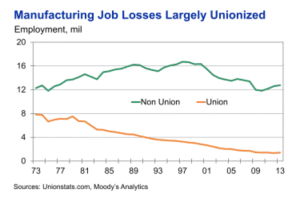Here’s another passage from Paul Krugman’s recent anti-economics column on Wal-Mart, minimum wages, and the supposed inapplicability of standard supply-and-demand analysis to labor markets:
Specifically, this view implies that any attempt to push up wages will either fail or have bad consequences. Setting a minimum wage, it’s claimed, will reduce employment and create a labor surplus, the same way attempts to put floors under the prices of agricultural commodities used to lead to butter mountains, wine lakes and so on. Pressuring employers to pay more, or encouraging workers to organize into unions, will have the same effect.
But labor economists have long questioned this view…
… a questioning that Krugman, judging from this column of his, clearly believes to be appropriate.
Bob Murphy has done good work exposing Krugman’s deep inconsistency on this issue. (See also David Henderson – and the comments, especially the one by Charley Hooper, in David’s post.) But inconsistent or not, here’s some evidence that Krugman is mistaken to suppose that, because labor markets (as he correctly says) are conditioned by “social forces and political power,” such forces and power cause labor markets to operate in ways that differ from the ways predicted by standard supply-and-demand analysis:

This graph (which you can click on to enlarge) is from this recent blog post by Adam Ozimek. (HT Tyler Cowen) (See also this earlier, related post by Adam.) While not proof positive – few such proofs are available in any science whose subject matter is empirical reality – these data are strong evidence in support of the standard economics conclusion that artificially raising firms’ costs of employing some kinds of workers causes firms over time to employ fewer such workers than they would otherwise have employed.
It appears that the social forces and political power that affect the market for labor do not do so in ways that render inapplicable the laws of supply and demand.
Note, too, from Adam’s posts that at least some respected labor economists – e.g., Richard Freeman (no libertarian he!) – don’t follow the script that Krugman says they follow.
….
Again, no sensible economist denies that labor markets differ in many ways from other markets. But each of these differences – including those that involve “social forces and political power” – can be captured quite well in standard supply-and-demand analysis. Doing so is the sort of work that good economists routinely do. Supply-and-demand analysis applies whenever potential buyers encounter potential sellers – and no one is a potential or actual buyer of a good or service that isn’t scarce, which practically means that no one is a seller of a good or service that isn’t scarce. And scarcity is never made to miraculously disappear by social forces or by political power. Because supply-and-demand analysis captures so well the allocation of scarce things, the fact that the scarce thing directly exchanged in labor markets is the labor-time of human beings in no way makes this analysis inapplicable.
Remember, all exchange is of things or abilities owned – things or abilities created, produced, or procured – by human beings. That labor markets coordinate the direct exchange of labor time – rather than the indirect exchange of labor time through the exchange of goods and services that labor, usually along with other inputs, produces – does nothing to make supply-and-demand analysis less applicable. The sellers of asparagus in the asparagus market are no less human than are the sellers of labor time in the labor market. And there is absolutely no reason to suppose that social forces, political power, or all the wishful thinking of people who dislike economic reality somehow make the buyers of labor time unable or unwilling to buy less of a certain kind of labor time if the costs to those buyers of buying that kind of labor time rises.



